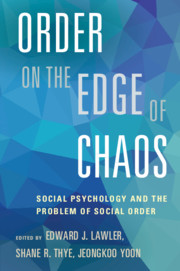Book contents
- Frontmatter
- Contents
- List of Contributors
- Preface
- 1 Social Psychology of Social Order: An Introduction
- 2 The Evolutionary Biology and Sociology of Social Order
- 3 Social Rationality and Weak Solidarity: A Coevolutionary Approach to Social Order
- 4 An Integrative Theory of Action: The Model of Frame Selection
- 5 The Center Cannot Hold: Networks, Echo Chambers, and Polarization
- 6 Social Exchange and Social Order: An Affect Theory Approach
- 7 Institutions, Trust, and Social Order
- 8 Identity Verifi cation and the Social Order
- 9 Identities, Roles, and Social Institutions: An Affect Control Account of Social Order
- 10 The Gender Frame and Social Order
- 11 Status, Power, and Social Order
- 12 Interaction Order: The Making of Social Facts
- 13 The Arts of Together: Social Coordination as Dyadic Achievement
- 14 Dignity as Moral Motivation: The Problem of Social Order Writ Small
- 15 The Legitimacy of Groups and the Mobilization of Resources
- Commentary: Contrasts and Complementarities
- Index
- References
2 - The Evolutionary Biology and Sociology of Social Order
Published online by Cambridge University Press: 05 December 2015
- Frontmatter
- Contents
- List of Contributors
- Preface
- 1 Social Psychology of Social Order: An Introduction
- 2 The Evolutionary Biology and Sociology of Social Order
- 3 Social Rationality and Weak Solidarity: A Coevolutionary Approach to Social Order
- 4 An Integrative Theory of Action: The Model of Frame Selection
- 5 The Center Cannot Hold: Networks, Echo Chambers, and Polarization
- 6 Social Exchange and Social Order: An Affect Theory Approach
- 7 Institutions, Trust, and Social Order
- 8 Identity Verifi cation and the Social Order
- 9 Identities, Roles, and Social Institutions: An Affect Control Account of Social Order
- 10 The Gender Frame and Social Order
- 11 Status, Power, and Social Order
- 12 Interaction Order: The Making of Social Facts
- 13 The Arts of Together: Social Coordination as Dyadic Achievement
- 14 Dignity as Moral Motivation: The Problem of Social Order Writ Small
- 15 The Legitimacy of Groups and the Mobilization of Resources
- Commentary: Contrasts and Complementarities
- Index
- References
Summary
Abstract
By examining the evolutionary biology of hominins and then humans, it is possible to construct more robust explanations for how dynamics at the micro level of social organization affect the integration of the micro, meso, and macro realms that constitute social reality. In this chapter, the evolution of hominins and eventually humans is reviewed with an eye to understanding how the pre-adaptations and behavioral propensities of hominins could be selected upon to create a more emotional animal, Homo sapiens, that was not locked into the group and kin structures of most mammals, with the result that humans have been able to build up solidarities at the group level that do not lock Homo sapiens into the micro social universe. Rather, the same emotional dynamic that generate micro-level solidarities can, under specified conditions, cause integration of the micro with the macro social universe composed of institutional domains, stratification systems, and societies. Evolutionary sociology is not just an esoteric program of theory and research but, rather, an approach that can shed new light on old theoretical problems.
Sociology emerged as a discipline to explain the dramatic changes associated with industrialization and urbanization. These new social orders appeared to be on the edge of chaos for many of those living through the tumultuous transition from agrarian to industrial social formations. Indeed, the first generations of sociologists in the nineteenth century posited a wide variety of “pathologies” inhering in the structure and culture of modern societies. In analyzing these transformative transitions, most early theorists employed an evolutionary approach, outlining the forces that had driven societies from simple to ever-larger and more complex patterns of social organization; and all had implicit conceptions of how these formations violated the fundamental nature of humans, thereby generating personal pathologies from alienation through egoism to marginality. Indeed, these are still the central problematics of much critical sociology and sociology more generally, but now we can approach questions of human nature and the relation of this nature to patterns of social organization with more sophisticated analytical tools that reduce speculation and downplay the often highly evaluative overtones of much sociological analysis of the human condition and society.
- Type
- Chapter
- Information
- Order on the Edge of ChaosSocial Psychology and the Problem of Social Order, pp. 18 - 42Publisher: Cambridge University PressPrint publication year: 2015
References
- 1
- Cited by



